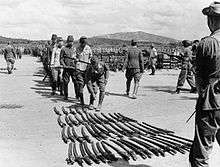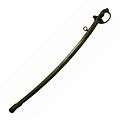Guntō

Guntō (軍刀, military sword) is the name used to describe Japanese swords produced for use by the Japanese army and navy after the end of the samurai era in 1868. In the following era (Meiji Period 1868-1912) samurai armour, weapons and ideals were gradually replaced with western influenced uniforms, weapons and tactics. Japan developed a conscription military in 1872 and the samurai lost the status they held for hundreds of years as the protectors of Japan.[1] Mass-produced guntō swords became standard equipment in the new military, taking the place of the swords worn by the samurai class during the feudal era.
History and description

During the Meiji Period, the samurai class was gradually disbanded, and the Haitōrei Edict in 1876 forbade the carrying of swords in public except for certain individuals such as former samurai lords (daimyo), the military and police.[2] Skilled swordsmiths had trouble making a living during this period as Japan modernized its military and many swordsmiths started making other items such as cutlery. Military action by Japan in China and Russia during the Meiji period helped revive the manufacture of swords and in the Shōwa Period (1926-1989) before and during World War II swords were once again produced on a large scale.[3]
During the pre World War II military buildup and throughout the war, all Japanese officers were required to wear a sword. Traditionally made swords were produced during this period but, in order to supply such large numbers of swords, blacksmiths with little or no knowledge of traditional Japanese sword manufacture were recruited. In addition, supplies of the type of Japanese steel (tamahagane) used for sword making were limited so several other types of steel were substituted. Shortcuts in forging were also taken, such as the use of power hammers and tempering the blade in oil rather than hand forging and water tempering; these measures created swords without the usual characteristics associated with Japanese swords. The non traditionally made swords from this period are called "Showato" and in 1937 the Japanese government started requiring the use of special stamps on the tang to distinguish these swords from traditionally made swords. During this wartime period antique swords from older time periods were remounted for use in military mounts. Presently in Japan Showato are not considered to be true Japanese swords and they can be confiscated; outside Japan they are collected as historical artifacts.[4][5][6]
Types
Kyū guntō (old military sword)
The first standard sword of the Japanese military was known as the kyū guntō (旧軍刀, old military sword). Murata Tsuneyoshi (1838-1921), a Japanese general who previously made guns, started making what was probably the first mass-produced substitute for traditionally made samurai swords. These swords are referred to as "Murata-to" and they were used in both the Sino-Japanese war (1894-1895) and the Russo-Japanese war (1904-1905).[7] The kyū guntō was used from 1875 until 1934, it closely resembled European and American swords of the time, with a wraparound hand guard (also known as a D-Guard) and chrome plated scabbard (saya), the steel scabbard is said to have been introduced around 1900.[8][9]
Shin guntō (new military sword)

The Shin guntō (新軍刀, new military sword) was a weapon and badge of rank used by the Imperial Japanese Army between the years of 1935 and 1945. During most of that period, the swords were manufactured at the Toyokawa Naval Arsenal. In response to rising nationalism within the armed forces, a new style of sword was designed for the Japanese military in 1934. The shin guntō was styled after a traditional slung tachi of the Kamakura period (1185-1332). Officers' ranks were symbolized by coloured tassels tied to a loop at the end of the hilt. The corresponding colors were brown/red & gold General; brown & red field officer; brown & blue company or warrant officer; brown sergeant, sergeant major or corporal.[10] The blades found in shin guntō ranged from modern machine made blades through contemporary traditionally manufactured blade to ancestral blades dating back hundreds of years.
Type 94
The "Type 94" shin guntō (九四式軍刀 kyūyon-shiki guntō) officers sword replaced the western style kyu gunto in 1934. It had a traditionally constructed hilt (tsuka) with ray skin (same) wrapped with traditional silk wrapping (ito). A cherry blossom (a symbol of the Imperial Japanese Army) theme was incorporated into the guard (tsuba), pommels (fuchi and kashira), and ornaments (menuki).
The scabbard for the Type 94 was made of metal with a wood lining to protect the blade. It was often painted brown and was suspended from two brass mounts, one of which was removable and only used when in full dress uniform. The fittings on the scabbard were also decorated with cherry blossom designs.
Type 95
The "Type 95" shin guntō (九五式軍刀 kyūgō-shiki guntō) released in 1935 was designed for use by non-commissioned officers (NCOs). It was designed to resemble an officer's Shin Guntō but be cheaper to mass-produce. All NCO swords had machine made blades with deep fullers (bo hi) and a serial number stamped on the blade in arabic numerals. Initially the hilts were cast out of metal (either copper or aluminum) and painted to resemble the traditionally produced items on the officer's swords. They had brass guards similar to the officer's shin guntō.
By 1945 a simplified NCO sword was being produced. It had a simple wooden hilt with cross hatched grooves for grip. The scabbards were made from wood instead of metal and the guard and other fittings were made from iron instead of brass.
Type 98

The change to the "Type 98" shin guntō (九八式軍刀 kyūhachi-shiki guntō) occurred in 1938 and was essentially a simplification of the "Type 94". There were only minor differences between early "Type 98" swords and the "Type 94" swords that preceded them. Most notably the second (removable) hanging point was omitted from the scabbard.
Many changes occurred to the "Type 98" between 1938 and the end of the war in 1945. Late in the war Japan's supply of metal was drying up and shin guntō were produced with painted wooden scabbards, and with cheaper or no brass ornamentation. Some of the final swords produced in the last year of the war utilized cheap copper or blackened iron fittings.
Kaiguntō (naval sword)
Kaiguntō (海軍刀, naval sword) are the less common naval version of the shin guntō.[11] Some kai gunto were produced with stainless steel blades.[12]
Gallery
 Kyū guntō, a design heavily inspired by European sabers.
Kyū guntō, a design heavily inspired by European sabers. Type 95 Non Commissioned Officers katana, with a cast metal painted hilt designed to look like a traditionally wrapped tsuka.
Type 95 Non Commissioned Officers katana, with a cast metal painted hilt designed to look like a traditionally wrapped tsuka.- Kai guntō with a ray skin scabbard.
See also
| Wikimedia Commons has media related to Guntō. |
References
- ↑ The Encyclopedia of Nineteenth-Century Land Warfare: An Illustrated World View, Author Byron Farwell, Publisher W. W. Norton & Company, 2001, ISBN 0393047709, 9780393047707 p.437
- ↑ The Connoisseur's Book of Japanese Swords, Author Kōkan Nagayama, Publisher Kodansha International, 1997 ISBN 4770020716, 9784770020710 P.43
- ↑ Samurai: The Weapons And Spirit Of The Japanese Warrior, Author Clive Sinclaire, Publisher Globe Pequot, 2004, ISBN 1592287204, 9781592287208 P.58-59
- ↑ Modern Japanese Swords and Swordsmiths: From 1868 to the Present, Authors Leon Kapp, Hiroko Kapp, Yoshindo Yoshihara, Publisher Kodansha International, 2002 ISBN 4770019629, 9784770019622 P.58-70
- ↑ The Connoisseur's Book of Japanese Swords, Author Kōkan Nagayama, Publisher Kodansha International, 1997 ISBN 4770020716, 9784770020710 P.43
- ↑ Samurai: The Weapons And Spirit Of The Japanese Warrior, Author Clive Sinclaire, Publisher Globe Pequot, 2004, ISBN 1592287204, 9781592287208 P.58-59
- ↑ Modern Japanese Swords and Swordsmiths: From 1868 to the Present, Authors Leon Kapp, Hiroko Kapp, Yoshindo Yoshihara, Publisher Kodansha International, 2002, ISBN 4770019629, 9784770019622 P.42
- ↑ War in the Pacific: Pearl Harbor to Tokyo Bay : the Story of the Bitter Struggle in the Pacific Theater of World War II, Featuring Commissioned Photographs of Artifacts from All the Major Combatants, Author Bernard C. Nalty, Publisher University of Oklahoma Press, 1999, ISBN 0806131993, 9780806131993 P.10
- ↑ The Japanese Army 1931-42, Volume 1 of The Japanese Army, 1931-45, Author Philip S. Jowett, Publisher Osprey Publishing, 2002, ISBN 1841763535, 9781841763538 P.41
- ↑ The Japanese Army 1931-42, Volume 1 of The Japanese Army, 1931-45, Author Philip S. Jowett, Publisher Osprey Publishing, 2002, ISBN 1841763535, 9781841763538 P.41
- ↑ Samurai: The Weapons And Spirit Of The Japanese Warrior, Author Clive Sinclaire, Publisher Globe Pequot, 2004, ISBN 1592287204, 9781592287208 P.85
- ↑ Warman's World War II Collectibles: Identification and Price Guide, Author John F. Graf, Publisher F+W Media, Inc, 2007, ISBN 0896895467, 9780896895461 P.212